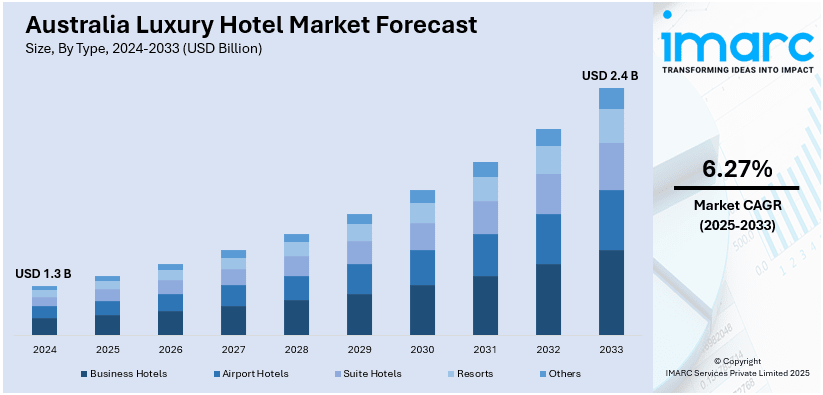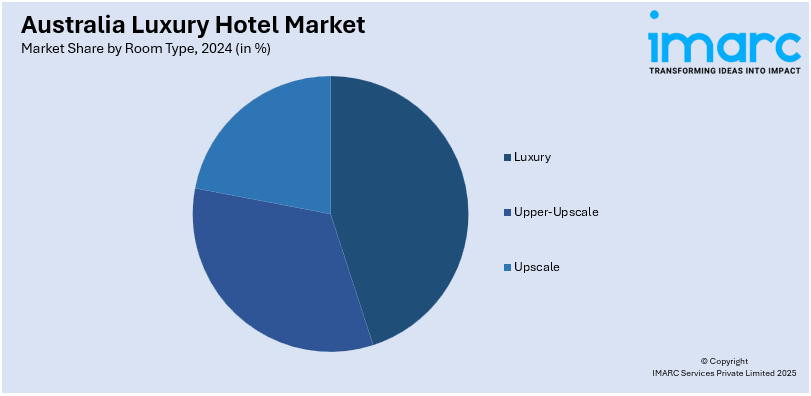
Australia Luxury Hotel Market Size, Share, Trends and Forecast by Type, Room Type, Category, and Region, 2025-2033
Australia Luxury Hotel Market Overview:
The Australia luxury hotel market size reached USD 1.3 Billion in 2024. Looking forward, IMARC Group expects the market to reach USD 2.4 Billion by 2033, exhibiting a growth rate (CAGR) of 6.27% during 2025-2033. The rising demand from high-net-worth travelers, particularly from Asia, and a growing preference for exclusive, personalized experiences are expanding the Australia luxury hotel market share. Sustainability initiatives and eco-luxury offerings are attracting environmentally conscious guests. Additionally, Australia’s strong tourism recovery post-pandemic and investments in ultra-luxury boutique properties are fueling growth in the high-end hospitality market.
|
Report Attribute
|
Key Statistics
|
|---|---|
|
Base Year
|
2024 |
|
Forecast Years
|
2025-2033
|
|
Historical Years
|
2019-2024
|
| Market Size in 2024 | USD 1.3 Billion |
| Market Forecast in 2033 | USD 2.4 Billion |
| Market Growth Rate 2025-2033 | 6.27% |
Australia Luxury Hotel Market Trends:
Rising Demand for Sustainable Luxury Experiences
The growing demand for sustainable and eco-conscious hospitality experiences is majorly driving the Australia luxury hotel market growth. High-net-worth travelers are increasingly prioritizing properties that integrate environmental responsibility without compromising on luxury. Australia was identified as the top luxury destination in the Asia-Pacific region, with 35% of wealthy tourists planning to visit in 2024. This interest is high, especially in India, where 69% are planning trips, followed by 25% of Japanese travelers. Eighty-eight percent of travelers in this segment prioritize a culinary adventure, and 83% are seeking restaurants that have won awards, which is a strong driver behind the focus on upscale dining experiences. This spike in interest provides a significant growth opportunity for Australia’s luxury hotel and resort scene in hosting celebratory occasions and longer stays. Hotels are responding by adopting green building certifications, energy-efficient systems, and locally sourced organic dining options. For instance, some luxury resorts in Queensland and Victoria now feature solar-powered villas, zero-waste initiatives, and partnerships with indigenous communities to offer authentic cultural experiences. Additionally, guests are drawn to hotels with carbon-neutral commitments, such as carbon offset programs and plastic-free amenities. This trend aligns with global shifts toward responsible tourism, where affluent travelers seek meaningful stays that reflect their values. As sustainability becomes a key differentiator, luxury hotels in Australia are investing in eco-friendly innovations to attract discerning guests who value both opulence and environmental stewardship.

To get more information on this market, Request Sample
Growth of Luxury Wellness Tourism
Wellness-focused luxury travel is gaining momentum in Australia, with high-end hotels integrating advanced health and rejuvenation offerings to attract affluent guests. A research report from the IMARC Group indicates that the luxury travel market in Australia was valued at USD 37.4 Billion in 2023. It is projected to grow to USD 70 Billion by 2032, reflecting a compound annual growth rate (CAGR) of 6.60% from 2024 to 2032. Therefore, this is creating a positive Australia luxury hotel market outlook. In addition, properties are expanding beyond traditional spas to include medical wellness programs, bespoke fitness regimes, and holistic retreats featuring mindfulness and nutrition therapies. Destinations are becoming hubs for luxury wellness resorts, offering tailored programs such as sleep optimization, detox retreats, and longevity treatments. Many hotels now collaborate with wellness experts, including naturopaths and mental health coaches, to provide immersive, science-backed experiences. This trend reflects a global shift toward preventative health and self-care among wealthy travelers, who prioritize well-being alongside luxury. As demand grows, Australia’s high-end hotels are positioning themselves as leaders in the wellness tourism market, blending opulent accommodations with cutting-edge health innovations.
Australia Luxury Hotel Market Segmentation:
IMARC Group provides an analysis of the key trends in each segment of the market, along with forecasts at the country level for 2025-2033. Our report has categorized the market based on Type, room type, and category.
Type Insights:
- Business Hotels
- Airport Hotels
- Suite Hotels
- Resorts
- Others
The report has provided a detailed breakup and analysis of the market based on the type. This includes business hotels, airport hotels, suite hotels, resorts, and others.
Room Type Insights:

- Luxury
- Upper-Upscale
- Upscale
A detailed breakup and analysis of the market based on the room type have also been provided in the report. This includes luxury, upper-upscale, and upscale.
Category Insights:
- Chain
- Independent
The report has provided a detailed breakup and analysis of the market based on the category. This includes chain and independent.
Regional Insights:
- Australia Capital Territory & New South Wales
- Victoria & Tasmania
- Queensland
- Northern Territory & Southern Australia
- Western Australia
The report has also provided a comprehensive analysis of all the major regional markets, which include Australia Capital Territory & New South Wales, Victoria & Tasmania, Queensland, Northern Territory & Southern Australia, and Western Australia.
Competitive Landscape:
The market research report has also provided a comprehensive analysis of the competitive landscape. Competitive analysis such as market structure, key player positioning, top winning strategies, competitive dashboard, and company evaluation quadrant has been covered in the report. Also, detailed profiles of all major companies have been provided.
Australia Luxury Hotel Market News:
- April 02, 2025: HVL Hotels officially opened in Hunter Valley, New South Wales, with 65 lavish rooms, chef-led fine dining, and a European-inspired thermal spa. This five-star property aims to fill a gap in the Australian luxury hotel market and attract high-end customers locally and internationally. This significant development is poised to enhance Hunter Valley’s reputation as a top-tier destination for luxury tourism.
- November 26, 2024: Eve Hotel Sydney announced plans to debut in 2025 in the dynamic Wunderlich Lane precinct, offering a boutique luxurious stay with 65 elegantly designed rooms, plus a rooftop garden with expansive views of the city. This design-focused hotel harmoniously integrates art, culture, and culinary delights, transforming the landscape of luxury hospitality in Sydney.
Australia Luxury Hotel Market Report Coverage:
| Report Features | Details |
|---|---|
| Base Year of the Analysis | 2024 |
| Historical Period | 2019-2024 |
| Forecast Period | 2025-2033 |
| Units | Billion USD |
| Scope of the Report |
Exploration of Historical Trends and Market Outlook, Industry Catalysts and Challenges, Segment-Wise Historical and Future Market Assessment:
|
| Types Covered | Business Hotels, Airport Hotels, Suite Hotels, Resorts, Others |
| Room Types Covered | Luxury, Upper-Upscale, Upscale |
| Categories Covered | Chain, Independent |
| Regions Covered | Australia Capital Territory & New South Wales, Victoria & Tasmania, Queensland, Northern Territory & Southern Australia, Western Australia |
| Customization Scope | 10% Free Customization |
| Post-Sale Analyst Support | 10-12 Weeks |
| Delivery Format | PDF and Excel through Email (We can also provide the editable version of the report in PPT/Word format on special request) |
Key Questions Answered in This Report:
- How has the Australia luxury hotel market performed so far and how will it perform in the coming years?
- What is the breakup of the Australia luxury hotel market on the basis of type?
- What is the breakup of the Australia luxury hotel market on the basis of room type?
- What is the breakup of the Australia luxury hotel market on the basis of category?
- What is the breakup of the Australia luxury hotel market on the basis of region?
- What are the various stages in the value chain of the Australia luxury hotel market?
- What are the key driving factors and challenges in the Australia luxury hotel market?
- What is the structure of the Australia luxury hotel market and who are the key players?
- What is the degree of competition in the Australia luxury hotel market?
Key Benefits for Stakeholders:
- IMARC’s industry report offers a comprehensive quantitative analysis of various market segments, historical and current market trends, market forecasts, and dynamics of the Australia luxury hotel market from 2019-2033.
- The research report provides the latest information on the market drivers, challenges, and opportunities in the Australia luxury hotel market.
- Porter's five forces analysis assist stakeholders in assessing the impact of new entrants, competitive rivalry, supplier power, buyer power, and the threat of substitution. It helps stakeholders to analyze the level of competition within the Australia luxury hotel industry and its attractiveness.
- Competitive landscape allows stakeholders to understand their competitive environment and provides an insight into the current positions of key players in the market.
Need more help?
- Speak to our experienced analysts for insights on the current market scenarios.
- Include additional segments and countries to customize the report as per your requirement.
- Gain an unparalleled competitive advantage in your domain by understanding how to utilize the report and positively impacting your operations and revenue.
- For further assistance, please connect with our analysts.
 Request Customization
Request Customization
 Speak to an Analyst
Speak to an Analyst
 Request Brochure
Request Brochure
 Inquire Before Buying
Inquire Before Buying




.webp)




.webp)












